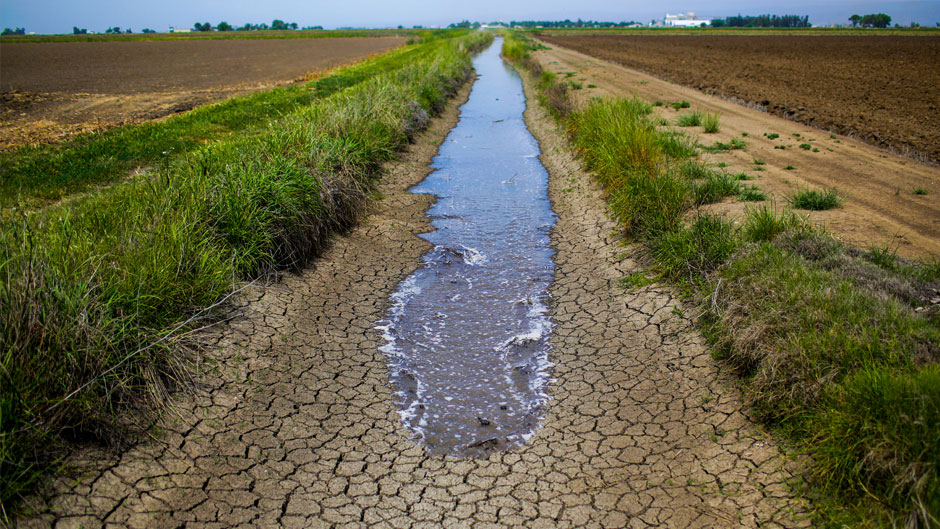Fresh water. It is a precious natural resource that is also critical to human survival. And the West Coast of the United States is struggling to manage it, particularly with a fluctuation in supply driven by climate change.
In times of drought, California’s Central Valley is full of farmers hindered by the lack of water. And this region, where the bulk of the nation’s fruits and vegetables are cultivated, is driving up the demand for water.
Although many farmers without easy access to water often buy and pump it in from their neighbors, droughts often fuel massive price increases. And this often makes water so cost-prohibitive that it can discourage farmers from even planting crops.
This predicament led a firm to recently list water as the newest commodity on the Chicago Mercantile Exchange. Now, water futures are traded daily. This helps farmers lock in a price for water, so they have a cushion if a drought threatens their crop revenues.
Experts at the University of Miami who study water and sustainable business practices weighed in on the advantages and pitfalls of hedging water prices this way.

To understand the water problem, said Justin Stoler, associate professor in geography and sustainable development, as well as public health sciences, one needs to get a sense of the patchwork of local laws governing water use in the western United States, particularly in California. These laws are based on a mix of riparian rights (given to those who own land bordering a waterway), and appropriative rights (or those who are the first in time to use a waterway), both of which often privilege farming families who have lived there the longest. In many California cities, water is subsidized by municipalities and is often pumped in from the nearest source—often the Sierra Nevada Mountains or the Colorado River.
These laws gave those who have lived on the land the longest no motivation to conserve water. Instead, it prompted many of these farms to grow crops like nuts that require extensive watering, added David Kelly, professor of economics and academic director of the Master’s in Sustainable Business in the Miami Herbert Business School. But that led to unsustainable water use. Therefore, in the 1970s and ’80s, municipalities began to allow water trading, where families with senior water rights could sell some of their water to newer farms. This encouraged farms to conserve more water.
“A place that’s given a lot of water will not waste it if they can sell it to someone else,” said Kelly. “So, there’s an incentive to install improved irrigation technology and save water now.”
Still, Kelly said, this situation did not help more recent farmers during a drought. If these farmers have to pay premium prices for water during a drought, it could put them out of business because the inflated water prices could cancel out any profit they might make from the crops.
“This happens all the time,” Kelly added.

That’s why many farmers today buy crop insurance. And now, they can also buy water futures to hedge against any water price hikes that could deplete their crop revenues. Anyone else interested in making some money—should a drought ensue—can also buy water futures, the experts added. This threatens to drive up the price of water futures, Stoler said. Yet if a drought is less likely, investors can sell their water futures, driving the price of water down.
Although farmers may feel these price fluctuations first, the dwindling fresh water supply in the western United States isn’t just affecting agriculture. Many California communities are looking into other options for providing water to residents, rather than relying on pumping it from far away, according to Kelly. San Diego has started building its own desalinization plant to take water from the Pacific Ocean and convert it to drinking water. However, these are expensive plants to build and operate, so many California businesses are working to save water through novel environmental infrastructure.
“With climate change and everything else, now is time for these plants, but there are lots of regulatory hurdles to overcome,” Kelly noted.
Stoler indicated that the water futures market is a temporary fix in an ongoing struggle for western farmers, similar to the way that oil futures helped the airline industry hedge on fuel prices and rebound after several airlines went bankrupt in the late-2000s.
But while the water futures market could be a short-term solution, it does not provide a lasting fix, acknowledged Stoler and Kelly.
“The problem is there’s not enough water fundamentally at the prices people want to pay for it, so at the end of day, California will have to make some choices,” Kelly said.
Ideas like farmers substituting low-water crops and purchasing more advanced irrigation systems to conserve water, as well as businesses using things like no flush urinals or utilizing reclaimed water for some watering needs, may be viable alternatives, Kelly pointed out.
Stoler, who studies water access all over the globe as a public health issue, said that it would be better for the Golden State to continue revising its water access laws to improve equity and water management among landowners, no matter how long they have lived in the area.
Yet, Stoler also states that the United States is setting a dangerous precedent by allowing financial markets to determine the price of water.
“As freshwater becomes increasingly scarce, people are worried about the power that private companies can have over that water,” said Stoler, a founding member of the Household Water Insecurity Experiences (HWISE) Research Coordination Network, an international collaborative funded by the National Science Foundation to study water-related issues.
“It may be okay to trade other products that can be substituted with alternatives, but when it comes to agriculture, water has no substitute,” explained Stoler. “It almost never improves water access or equity when a small group of elite actors have control over the water. What will be the ripple effects and unintended consequences if the whole world continues to commodify water? It’s probably not going to end well.”

